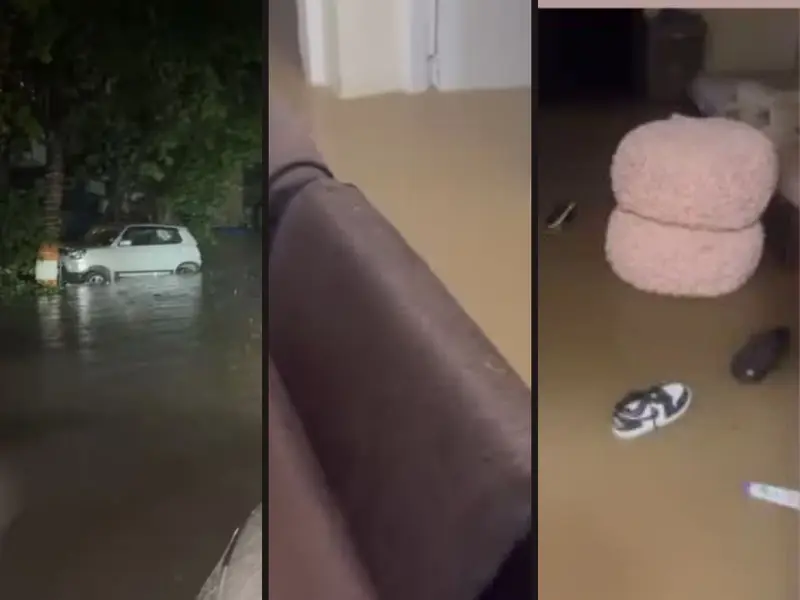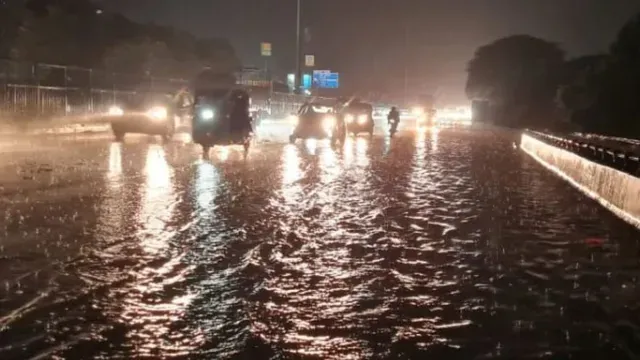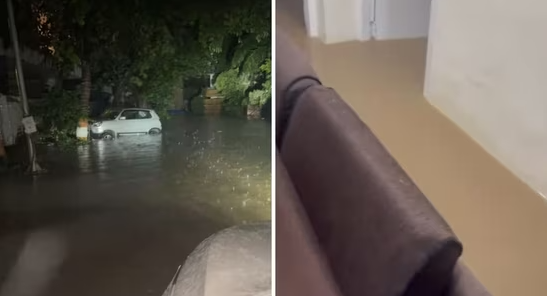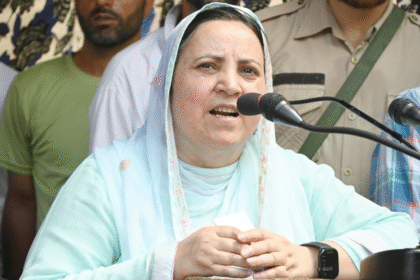₹25 Lakh Gurgaon Apartment Hit by Extreme Rain: 3-Foot Waterlog Submerges Home in Luxury Society
₹25 Lakh Gurgaon Apartment Hit by Extreme Rain: 3-Foot Waterlog Submerges Home in Luxury Society. A resident returns to find her upscale flat severely impacted after intense downpour floods the premises.
Torrential Rains Unleash Chaos on Gurgaon’s Urban Infrastructure
A Monsoon That Became a Nightmare
In early July 2025, Gurgaon—also known as Gurugram—witnessed an urban disaster triggered by relentless monsoon rains that battered the city for over four continuous hours. The storm turned the upscale suburbs of one of India’s wealthiest satellite cities into pools of stagnant, destructive water, submerging vehicles, flooding homes, and leaving behind a trail of destruction that continues to evoke shock on social media and in civic discourse.
The story that captured national attention was that of Sanchi Arora, a young professional who returned to her upscale apartment near Golf Course Road only to find it submerged, with furniture floating, electronics soaked, and memories drowned in inches of water. Her poignant social media post, accompanied by a video from her waterlogged home, became the face of a broader failure in Gurgaon’s urban planning and flood management.
The Brutal Weather Event
On the night of July 10th, weather systems over Delhi-NCR aligned to produce a high-intensity downpour. According to the India Meteorological Department (IMD), parts of Gurgaon received over 180 mm of rain within four hours—a rate equivalent to what some towns receive in an entire month. Roads quickly turned into canals, underpasses into ponds, and ground floors into indoor pools.
The rain’s impact extended far beyond mere inconvenience. On Sohna Road, Golf Course Extension Road, Sheetla Mata Road, and NH-48 (Delhi-Jaipur Highway), traffic snarled for hours. Commuters were left trapped in their vehicles from late evening until past midnight as water levels rose and roads disappeared under floodwaters.
The Woman Behind the Viral Video: Sanchi Arora’s Story
Sanchi Arora, who lives near the Golf Course Road stretch famous for luxury properties like DLF The Camellias (where homes reportedly sell for ₹100 crore and above), returned from work only to encounter devastation. Her car was half-submerged. Inside her house, furniture was overturned, appliances were destroyed, and cherished personal belongings floated aimlessly in foul water.
In her social media post, she wrote:
“This is my home. A home I had carefully and lovingly set up after I moved in. Everything that was on the floor — furniture, belongings — was floating, soaked, and destroyed. I have no words left. Just pain. Just disbelief. This is not just water damage. It’s emotional damage. And it’s real.”
Her video quickly went viral, with users expressing outrage, grief, and frustration—not just over her personal loss but over the systemic failure it represented. Despite the apparent affluence of her locality, the rain exposed how little had been done to address fundamental infrastructure and drainage.
Response from Real Estate Developer DLF
Given the public speculation that Sanchi may have resided in one of DLF’s premium societies, the real estate giant responded via a spokesperson:
“We would like to clarify that the woman’s post in question does not state that she resides in Camellias or even on Golf Course Road. It only mentions that the incident occurred near Golf Course Road, which importantly spans nearly 10 km and includes several residential and commercial developments.”
While this clarification distances the brand from direct blame, it inadvertently underscores a larger urban concern: even areas marketed as elite and resilient are vulnerable to infrastructural collapse during extreme weather.
Public Reaction and Societal Discourse
The online reaction was swift and intense. Social media users expressed empathy, shared their own flood experiences, and questioned the viability of investing in high-end urban real estate.
One user wrote:
“If anyone has 10 crores or above, they should go to a foreign nation. Pay taxes and live a life with dignity and security infrastructure. India has no direction, paper plans, a social divide, and huge corruption.”
Another added:
“This happens when you are desperate to develop real estate and mint money by selling plots and farmlands but don’t care about city planning and basic human needs.”
A third remarked:
“This is why I told my boyfriend to take a home in Noida instead of Gurugram: I’ve already faced these issues while living in Gurgaon. Horrible drainage system.”
The incident has fueled broader concerns about real estate-led urbanisation in India, especially in rapidly expanding satellite cities like Gurgaon, where aesthetics and profit margins often appear to trump infrastructure and sustainability.
Death, Deluge, and Systemic Breakdown: Gurgaon’s Infrastructure in Crisis
Human Toll: Deaths and Hazards Multiply
While property loss and emotional distress dominated the headlines, the full human toll of the downpour came into sharper focus the following morning. According to official reports from Gurgaon Police, five people lost their lives due to rain-related incidents on July 10 and 11. Three of those fatalities were attributed to electrocution—a chilling indicator of how rainwater met faulty or exposed electrical infrastructure in public areas.
In one such case, a man was electrocuted while trying to push a scooter through a flooded lane. In another, a delivery worker stepped into standing water near a streetlight and collapsed immediately. The police are investigating possible negligence and have issued advisories urging people to avoid contact with metal surfaces and electric poles during heavy rains.
Traffic Nightmares and Commuter Traps
The immediate aftermath of the storm saw Gurgaon’s most vital roads—Delhi-Jaipur Highway (NH-48), Sohna Road, Golf Course Extension Road, and Sheetla Mata Road—turn into gridlocked hellscapes. Thousands of commuters remained stranded for over five hours, with some abandoning their vehicles in waist-deep water to seek shelter.

Visuals circulated online showed hundreds of cars stuck bumper-to-bumper, engine compartments submerged and hazard lights blinking in unison. The resulting traffic collapse exposed serious vulnerabilities in traffic management systems, emergency evacuation protocols, and urban flood preparedness.
Drainage System Collapse: A Long-Festering Problem
While the rain event was intense, the damage was not solely due to nature. Urban planners and environmentalists have long warned about Gurgaon’s inadequate and poorly maintained drainage network. Years of unregulated construction, encroachment on natural drainage channels, and insufficient sewage capacity have made the city highly vulnerable to even moderate rainfall.
Despite repeated monsoon emergencies over the past decade, successive administrations—both municipal and private—have failed to implement lasting solutions. Reports suggest that less than 30% of the city has a functioning stormwater drain system that connects to a main outflow, and in many areas, drains are either blocked by debris or paved over during development.
Real Estate Versus Resilience: Gurgaon’s Planning Deficit
Once marketed as the symbol of India’s global ambitions, Gurgaon’s glass towers and manicured landscapes now stand in stark contrast to its crumbling civic infrastructure. Urban development here has been largely driven by private real estate interests rather than public welfare metrics.
Luxury condominiums boast of Olympic-sized pools, rooftop gardens, and high-speed elevators, yet residents frequently complain of basic issues like water logging, poor garbage disposal, and delayed response to public safety incidents. Critics argue that the city is being built vertically without adequate horizontal infrastructure to support its growing population.
The result is a city vulnerable not just to natural elements but to its own unchecked growth.
Government Response: Promises Amidst Crisis
Following the flood, Haryana’s Urban Local Bodies (ULB) Department and the Municipal Corporation of Gurugram (MCG) issued statements promising urgent repair and inspection drives. Teams were dispatched to assess vulnerable zones, clear blocked drains, and deploy temporary pumps in low-lying areas.
However, residents and activists remain skeptical. Many pointed out that similar promises were made after the 2016 and 2018 floods, yet systemic improvements never materialised. The public is increasingly calling for judicial inquiries, third-party audits of urban infrastructure, and holding builders accountable for neglecting flood mitigation requirements.
Lessons Unlearned: Will This Be a Turning Point?
Urban planners emphasize that cities like Gurgaon must fundamentally rethink their development models. Climate resilience must be embedded into every stage of planning—from land use and construction permits to public infrastructure and disaster preparedness.
Experts from the Centre for Science and Environment (CSE) and the School of Planning and Architecture have reiterated the need for:
- Decentralized drainage systems
- Wetland restoration
- Stricter building codes
- Climate-sensitive zoning
Until such reforms are pursued in earnest, cities like Gurgaon will remain exposed to the combined threats of extreme weather and administrative apathy.
Inside the Fallout: Economic Losses, Psychological Trauma, and the Cost of Ignoring Resilience
Counting the Cost: Property, Insurance, and Economic Fallout
In the days following the Gurgaon floods, thousands of residents began the painful process of assessing damages. From ruined sofas and waterlogged electronics to collapsed ceilings and cracked flooring, the financial toll was staggering. Preliminary estimates by property management bodies suggest that over ₹100 crore in private residential damage occurred across Gurgaon’s high-rises and independent houses alone.
For many like Sanchi Arora, who shared her story online, the damage was not covered by home insurance, or only partially so. Most urban homeowners either don’t opt for comprehensive flood coverage or aren’t aware it exists. The sudden spike in claims overwhelmed local insurance companies, most of which began reevaluating policies and exclusions for flood-prone zones.
Real estate experts also reported a slowdown in inquiries and transactions in flood-affected sectors of Gurgaon, particularly around Golf Course Extension, Sohna Road, and New Gurugram. For an economy that heavily relies on real estate investments, the impact was not just personal—it was systemic.
Mental Health After the Monsoon: Grief, Anxiety, and Displacement
While media coverage focused heavily on property loss and government failures, the psychological impact on affected residents was equally profound. In interviews conducted by local NGOs and housing societies, dozens of residents reported symptoms of post-traumatic stress: sleeplessness, fear of future rains, anxiety over financial recovery, and helplessness.
Children missed school as their books and uniforms were destroyed. Adults found it hard to return to work amidst cleanup efforts and insurance bureaucracy. Elderly citizens—many living alone in luxury towers—suffered isolation, stress-induced ailments, and in some cases, displacement to temporary accommodations.
Clinical psychologists in Gurgaon reported a 40% rise in walk-in cases after the flood week, especially among apartment residents and young parents. Experts have stressed the need for psychological first aid and long-term mental health support in urban disaster response frameworks—an area often overlooked.
Urban Inequities Exposed: The Poor Suffer More Silently
As media spotlights shone on elite residential towers, a quieter, more devastating crisis unfolded in unauthorized colonies and low-income settlements. Places like Basai, Chakkarpur, and Nathupur reported sewage mixed with floodwater entering homes, damaging tin-roof shanties and kutcha houses.
Daily-wage workers lost entire week’s earnings and food supplies. Children waded through waist-deep water to retrieve school bags. Without insurance, legal land titles, or public visibility, these citizens had no claims for relief or compensation.

Civil society groups, while praising the attention given to upscale losses, criticised the class disparity in both media coverage and government response. Relief camps, water tankers, and mobile clinics appeared far more frequently near gated societies than in slums or low-rise settlements.
Civic Mobilization: Residents Step Up as First Responders
Despite the institutional vacuum, Gurgaon’s residents rallied with urgency. RWAs (Resident Welfare Associations), gated society groups, and independent volunteers formed flood response teams. From clearing basement water to raising donations for domestic staff who lost homes, citizen groups filled the void left by slow municipal action.
Social media platforms were used to organise supply chains—food packets, dry clothing, medicines, and cleaning materials were mobilised within hours. In DLF Phase 4, residents created a shared database of service providers including plumbers, electricians, and pest control to assist affected neighbors.
Such examples of community resilience sparked a broader discussion: Should disaster preparedness be decentralized to the RWA and community level in Indian cities? Experts argue that building capacity at the grassroots could bridge the response gap until professional help arrives.
Political Reactions and Blame Games
As with most urban disasters in India, politics followed closely behind tragedy. Leaders from multiple parties descended on flood-hit areas, promising swift compensation, urban renewal, and accountability. However, much of the discourse quickly devolved into finger-pointing.
While Haryana’s ruling leadership blamed ‘climate unpredictability’ and ‘excessive encroachment,’ opposition figures accused the government of colluding with private developers and failing to enforce building codes. Petitions were filed in Punjab and Haryana High Court seeking judicial scrutiny of Gurgaon’s drainage master plans and real estate clearances.
In Parliament, MPs from NCR constituencies demanded a national-level urban flood management strategy, calling Gurgaon a case study of “urban ambition gone unchecked.”
Rebuilding Trust: Planning, Policy, and Preparing for the Next Downpour
Urban Planning Reform: From Reaction to Prevention
The aftermath of the Gurgaon floods has reignited debates over urban governance and development models in India’s fastest-growing cities. Urban planning experts and civic architects argue that Gurugram—once touted as the emblem of India’s private-led urban boom—now represents a cautionary tale of unchecked expansion without environmental foresight.
Urban planners from the National Institute of Urban Affairs (NIUA) and Centre for Policy Research (CPR) have recommended a series of reforms including:
- Retrofitting existing drainage systems using hydrological modeling
- Protecting natural floodplains and nullahs from real estate encroachment
- Creating zonal-level flood hazard maps to guide land-use
- Enforcing stormwater guidelines in all new real estate approvals
The Haryana Urban Development Authority (HUDA) has reportedly commissioned a new drainage audit of Gurgaon’s critical sectors in collaboration with IIT Roorkee. However, previous recommendations from similar studies (e.g., 2010 TERI-Gurgaon Flood Risk Assessment) were never fully implemented.
National Urban Flood Policy: Missing in Action
While flood policy in India is robust at the rural and river-basin level (through the Central Water Commission and NDMA), there remains a glaring vacuum in urban flood governance. Experts have long called for a dedicated National Urban Flood Management Policy that outlines:
- Mandated disaster risk audits for city master plans
- Climate-risk insurance for urban households
- Legal penalties for blocked drains and faulty real estate planning
- Smart alert systems integrated with IMD and city response units
In the absence of such a framework, cities like Gurgaon remain reliant on local improvisation and citizen-led action.
Resilience by Design: Sustainable Architecture for Indian Cities
The architectural community is also stepping in with ideas for flood-resilient design in Indian urban spaces. Key recommendations include:
- Elevated plinth levels in residential construction
- Permeable pavements to aid ground absorption
- Green roofs and rain gardens for micro water harvesting
- Floodable parks and buffer zones to redirect runoff
Startups and sustainability firms are advocating modular infrastructure and climate-positive urban design. In Gurgaon’s new developments, some real estate brands have begun rebranding around “eco-integrated” architecture—but critics argue that without external audits, such moves risk becoming greenwashing exercises.

Community Preparedness: Building Flood-Resilient Citizens
The Gurgaon crisis has underscored that disaster readiness is not just the job of municipalities but must become a community-led ethic. Experts recommend integrating urban disaster drills into RWAs, schools, and commercial societies.
Suggestions include:
- Emergency SOPs (Standard Operating Procedures) for high-rises
- Localized flood kits with essential supplies
- Training in electrical shut-off, basic rescue, and water pump use
- Public display of flood zone maps in society noticeboards
Delhi NCR’s recent history—with repeated summer floods, AQI emergencies, and extreme heat—demands a cultural shift toward daily preparedness, not annual panic.
Building Public Trust Through Transparency
Residents interviewed across Gurgaon’s worst-hit sectors consistently voiced one demand: trust. The crisis, more than anything, eroded citizen confidence in institutions—from the municipal corporation and builders to emergency services and regulatory bodies.
Transparency initiatives recommended include:
- Public dashboards on city drainage health and complaints
- Builder rating systems that include environmental resilience
- Timely release of flood audit findings and budget expenditures
- Civil society oversight boards for infrastructure rollout
Only when residents see visible, honest engagement by their government and developers can the long process of rebuilding trust begin.
The Road Ahead: Can Gurgaon Emerge Stronger from the Flood Crisis?
Turning Point or Missed Opportunity?
With each monsoon season delivering heavier rainfall and increased flooding, the 2025 Gurgaon flood event may well be remembered as a critical juncture in India’s urban resilience journey. But whether this becomes a turning point or yet another missed opportunity depends largely on what comes next.
Policy inertia, bureaucratic inefficiencies, and piecemeal responses have plagued past disaster responses. Citizens and urban analysts alike are watching closely to see if the momentum built in the wake of public outrage and media scrutiny translates into institutional change.
Gurgaon as a Model for Resilience—Or Collapse
Gurgaon’s unique status as a privately developed, commercially vital, and globally connected city means its recovery will be watched far beyond Haryana. If it can emerge stronger—by retrofitting infrastructure, enforcing building accountability, and embedding climate resilience—it may serve as a model for future smart city planning.
However, if the current crisis is brushed aside or addressed superficially, Gurgaon risks becoming the archetype of India’s urban vulnerabilities: gleaming skyscrapers with crumbling civic foundations.
Role of Private Sector and Public-Private Partnerships
With real estate developers holding enormous influence in the city, their cooperation will be critical. Authorities must compel them to adopt sustainable practices—not just through moral appeals but regulatory and financial mechanisms.
Potential strategies include:
- Flood-resilience ratings affecting building approvals
- Developer contributions to municipal drainage upgrades
- Mandatory insurance and compensation funds for residents
Some companies have already signalled willingness to participate in citywide climate response plans—but residents demand enforceable commitments, not just corporate social responsibility (CSR) campaigns.
Education, Media, and Public Engagement
Gurgaon’s flood crisis has sparked an unprecedented amount of civic discussion on urban ecology, infrastructure planning, and environmental justice. Schools, colleges, media houses, and citizen forums now have an opportunity to keep that dialogue alive.
Institutions must incorporate climate awareness into education, media must sustain pressure for transparency, and citizens must stay informed and organized to demand accountability year-round—not just after disaster strikes.
A City’s Reckoning with Itself
In many ways, the Gurgaon flood of 2025 was not merely a weather event—it was a reckoning. A reckoning with the choices made over the last two decades in pursuit of rapid urbanisation, luxury living, and infrastructure built for aesthetics over resilience.
It forced India’s most aspirational city to look in the mirror and ask hard questions: Who is this city for? Who bears the cost when systems fail? Can the city grow without erasing its capacity to survive?
Gurgaon’s answer to these questions—through policy, planning, and people—will determine not just its own future, but serve as a barometer for India’s urban destiny in the age of climate change.
Also Read : Dalai Lama’s Presence in Dharamshala Boosts India’s Soft Power Advantage Over China After 64 Years in Exile








